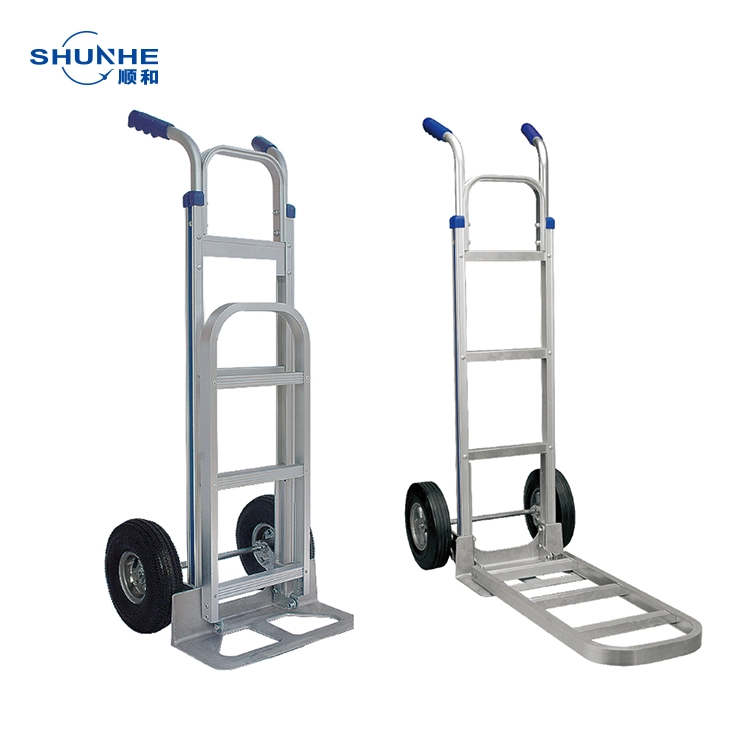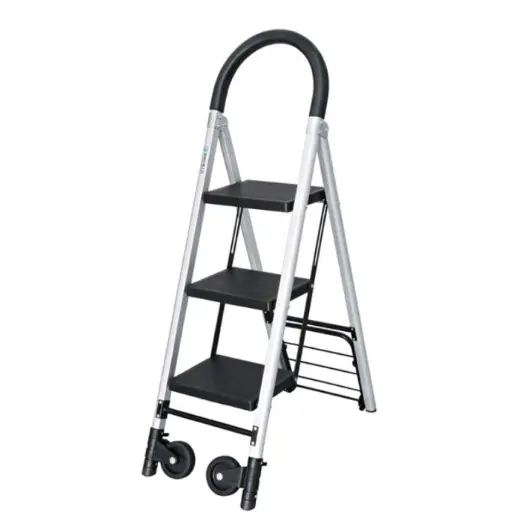Views: 220 Author: shunhehandtruck Publish Time: 2025-10-28 Origin: Site











Content Menu
● Understanding the basics of steel and aluminum
● Load capacity and structural considerations
● Durability, impact resistance, and longevity
● Corrosion resistance and environmental suitability
● Maintenance needs and routine care
● Cost considerations and total cost of ownership
● Noise, vibration, and ride quality
● Safety and ergonomic factors
● How to evaluate a candidate trolley
● FAQs
Two wheel hand trolleys are essential tools for moving heavy loads with minimal effort. When selecting the right trolley for your needs, the choice between steel and aluminum frames is one of the most important considerations. Each material brings its own strengths and trade-offs in terms of durability, weight, corrosion resistance, cost, and suitability for specific environments. This article examines the key factors to help you decide which material best fits your application, including performance under load, mobility, maintenance, and long-term total cost of ownership. We will also cover common use cases, maintenance tips, and practical buying considerations to ensure you make an informed decision.

Steel trolleys are typically praised for their exceptional strength and robustness. They can withstand higher static and dynamic loads and offer excellent resistance to impact and abrasion. Steel frames are often preferred in harsh environments where loads are heavy and reliability is paramount.
Aluminum trolleys, on the other hand, offer a superior weight-to-strength ratio. They are significantly lighter than steel without compromising too much on stiffness. Aluminum also tends to resist corrosion better in moist or humid environments, which can translate into lower maintenance requirements over time.
When evaluating load capacity, steel trolleys generally top the charts. If you routinely transport very heavy items, a steel trolley may provide a more comfortable margin for safety and performance. However, modern aluminum designs have advanced dramatically and can meet or approach similar load ratings for many applications, especially when reinforced with high-strength alloys and optimized geometry.
- Load distribution: Both materials rely on a strong axle system, wheel bearings, and a sturdy handle to distribute weight efficiently. Poor load distribution can cause wheel wear, frame flex, or tipping, regardless of material.
- Frame design: The overall performance is influenced by the frame geometry, cross-bracing, and the quality of welds or joints. A well-engineered aluminum trolley can perform as well as a steel counterpart for many everyday tasks.
Weight is a deciding factor in maneuverability, operator fatigue, and handling precision.
- Aluminum advantages: The lighter weight of aluminum translates into easier pushing, longer wheel life from reduced stress, and greater ease when negotiating stairs or ramps. For intermittent use or environments where personnel must carry and reposition trolleys frequently, aluminum often provides a tangible ergonomic benefit.
- Steel considerations: While heavier, steel trolleys tend to have excellent inertia once in motion and can feel more stable when moving very heavy loads over long distances on smooth surfaces. They can be less prone to flex under high torque scenarios.
Durability depends on more than just the material.
- Steel: Demonstrates superior impact resistance and fatigue performance in many industrial settings. It is less prone to denting under high-stress conditions and can be more forgiving in rugged environments.
- Aluminum: While strong, aluminum is more susceptible to certain types of wear, such as gouging or denting, though it resists corrosion. Aluminum frames can endure years of use if properly maintained, but care must be taken to avoid bending or cracking.
- Steel: Carbon steel frames can rust if not coated or treated, particularly in salty or humid environments. Stainless steel variants offer excellent corrosion resistance but at a higher cost and weight.
- Aluminum: Naturally corrosion-resistant due to an oxide layer, which makes aluminum trolleys particularly attractive in chemical plants, marine-adjacent facilities, and outdoor settings where exposure to moisture is common.
Regular maintenance extends the life of any trolley, regardless of material.
- Steel trolleys: Inspect for rust, repaint exposed areas, check weld integrity, and lubricate moving parts. If rust develops, treat proactively to prevent structural compromise.
- Aluminum trolleys: Check for dings that could weaken frame integrity, inspect fasteners for loosening, and keep wheels and bearings clean and lubricated. Aluminum does not rust, but it can suffer from galvanic corrosion if paired with incompatible metals in certain assemblies.
Initial price often reflects the material choice, but total cost of ownership includes maintenance, downtime, and replacement frequency.
- Steel trolleys: Usually lower upfront cost per unit but potentially higher maintenance costs if corrosion protection is inadequate or if surfaces require frequent repainting.
- Aluminum trolleys: Higher upfront cost but potential savings from lighter operation, reduced maintenance, and longer service life in corrosive environments.
The perceived ride quality can influence user adoption and comfort.
- Steel: Heavier mass can dampen some vibration but may transmit more energy back to the operator on uneven surfaces.
- Aluminum: Lighter mass can feel more agile but may require more careful design to minimize frame flex that could affect stability on rough floors.
A properly chosen trolley should enhance safety and reduce operator strain.
- Handling: Light aluminum trolleys reduce pushing effort, which can be beneficial for repetitive tasks.
- Stability: A well-designed steel trolley may offer a lower center of gravity in certain configurations, improving stability with very heavy loads.
To help you decide, consider the following common scenarios:
- Industrial warehouses with heavy, frequent loads and harsh floor conditions: Steel trolleys are often preferred for durability and load-bearing confidence.
- Outdoor work sites, docks, or humid environments: Aluminum trolleys generally offer better corrosion resistance and lighter weight for easier handling.
- Small businesses with mixed-use requirements: A high-quality aluminum trolley can strike a balance between ease of use and durability, especially if loads are not at the extreme end of capacity.
When comparing models, assess the following attributes:
- Load rating and safety factor: Ensure the stated capacity aligns with your typical loads with an appropriate safety margin.
- Wheel type and material: Pneumatic wheels absorb shocks; solid wheels reduce maintenance. The choice should reflect floor conditions and load frequency.
- Handle design: Ergonomics matter. Look for adjustable handles, comfortable grips, and secure steering mechanisms.
- Bracing and joints: Weld quality, bolt connections, and overall frame stiffness influence durability.
- Accessories: Consider ramps, toe guards, strap hooks, and braking systems that enhance usability.
- Specify environmental conditions: If you operate in coastal or wet environments, lean toward corrosion-resistant options and non-rusting finishes.
- Prioritize warranty and service availability: A robust warranty and accessible service network can dramatically reduce life-cycle costs.
- Request duty cycle data: For high-frequency use, verify the trolley's endurance under continuous operation.
- Regular inspections: Check wheels, axles, bearings, and fasteners on a schedule that matches usage intensity.
- Clean environments: Wipe down frames to remove dust, grime, and moisture after use.
- Lubrication routine: Apply appropriate lubricants to moving parts to minimize wear, especially in dusty or dirty environments.
- Storage: Store trolleys in a dry area to minimize exposure to corrosive elements.
- Steel: Maximum strength, excellent durability under heavy loads, greater weight, potential rust without protective coatings.
- Aluminum: Lighter, good corrosion resistance, generally easier to maneuver, higher upfront cost, potential for frame denting or deformation if mishandled.

- What is the typical weight difference between steel and aluminum two-wheel hand trolleys?
- How do I choose the right wheel type for my environment?
- Can aluminum trolleys handle very heavy loads as well as steel ones?
- What maintenance steps are essential to prolong trolley life?
- Are there hybrids or reinforced aluminum designs that combine benefits of both materials?
- How does corrosion protection influence long-term costs?
- What safety features should I prioritize when buying a trolley?
- How should I assess warranty terms for different materials?
- Do aluminum trolleys require special storage considerations?
- How do I prevent frame fatigue in high-use settings?
Hot Tags: China, Global, OEM, private label, manufacturers, factory, suppliers, manufacturing company
Why A Two Wheel Hand Trolley Is Essential for Efficient Logistics Operations?
How To Pick The Best Two Wheel Hand Trolley for Rough Terrain And Stairs?
Choosing Between Steel And Aluminum Two Wheel Hand Trolleys: What You Need To Know?
How To Select A Durable And Efficient Two Wheel Hand Trolley?
What To Look for When Buying A Two Wheel Hand Trolley: Expert Tips?
How To Choose The Right Two Wheel Hand Trolley for Your Business?
Best Two Wheel Hand Trolleys for Moving Heavy Loads: Our Top Picks
Leading Two Wheel Hand Trolley Manufacturers in China: Quality And Innovation
Top Manufacturers of Two Wheel Hand Trolleys: Why Choose Guangdong Shunhe?
Best Two Wheel Hand Trolleys in 2025: Features, Benefits, And Buyer’s Guide